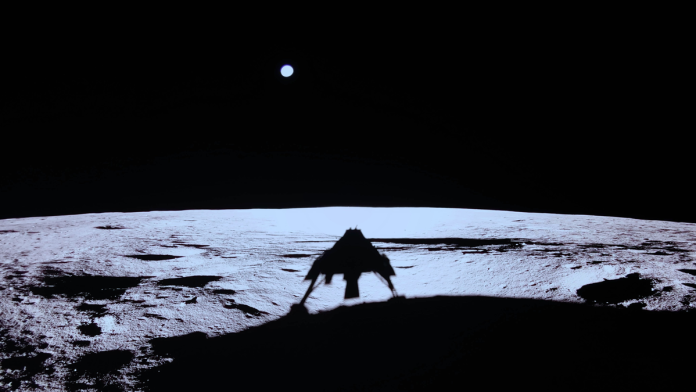The historic mission of Firefly Aerospace’s Blue Ghost lunar lander has concluded.
The solar-powered Blue Ghost went dark on Sunday evening (March 16) after the sun set on its lunar locale, marking the end of a successful two weeks of surface operations on the moon.
“We tested every system on the lander and simulated every mission scenario to reach this point,” Blue Ghost Chief Engineer Will Coogan stated in a statement from Firefly today (March 17) announcing the end of the mission.
“What sets this team apart is the passion and commitment to each other,” he added. “Our team may appear younger and less experienced than others that attempted moon landings, but the support for one another fueled hard work and dedication to finding solutions that led to the success of this mission.”
Blue Ghost’s mission, dubbed “Ghost Riders in the Sky” by Firefly, was the company’s inaugural lunar effort. Supported by NASA’s Commercial Lunar Payload Services (CLPS) program, the mission delivered 10 NASA payloads to Mare Crisium (“Sea of Crises”) on the lunar near side on March 2. This successful touchdown was only the second private lunar lander landing, following Intuitive Machines’ Odysseus vehicle in February 2024.
The plan was for Blue Ghost and the science instruments to operate for a lunar day, approximately two Earth weeks, which was successfully accomplished, marking “Ghost Riders in the Sky” as 100% successful, Firefly confirmed today.
“Immediately after landing on the moon, the Firefly team transitioned to surface operations to ensure all 10 NASA payloads could collect as much science as possible during the lunar day,” stated Firefly CEO Jason Kim in the same release.
“We are proud of the demonstrations Blue Ghost facilitated, such as tracking GPS signals on the moon for the first time and drilling deeper into the lunar surface robotically,” Kim added. “We extend our gratitude to the NASA CLPS initiative and the White House administration for supporting this Firefly mission, enabling science and technology experiments for future missions to the moon, Mars, and beyond.”
Related: Experience the moon touchdown with the private Blue Ghost lander in this incredible video
Blue Ghost observed the “Blood Worm Moon” total lunar eclipse on March 13-14 and captured a stunning “diamond ring” photo of the event from its unique perspective.
The lander transmitted a total of 119 gigabytes (GB) of data, including 51 GB of scientific information before going dark as scheduled on Sunday around 7:15 p.m. EDT (2315 GMT), according to Firefly.
In its final hours, Blue Ghost “took images of the lunar sunset on March 16, providing NASA with data on the potential levitation of lunar dust due to solar influences and the creation of a lunar horizon glow,” as described by Eugene Cernan on Apollo 17, Firefly noted. “After the sunset, Blue Ghost operated for 5 hours into the lunar night, continuing to capture images to study how dust behavior changes post-sunset.”
“Ghost Riders in the Sky” is part of a trend in private moon exploration. Blue Ghost launched alongside another private lunar lander, Tokyo-based ispace’s Resilience, on Jan. 15, with Resilience scheduled to attempt its own landing on June 5.
Intuitive Machines’ second lunar lander, Athena, launched on Feb. 26 and landed near the moon’s south pole on March 6. Unfortunately, Athena tipped over after landing and was declared inactive on March 7, despite also being part of a CLPS mission.
This surge in lunar exploration is set to continue in the years to come, with Firefly already preparing for its second moon mission, launching in 2026. This mission will send Blue Ghost to the lunar far side and place Firefly’s “Elytra Dark” spacecraft in orbit around the moon.




